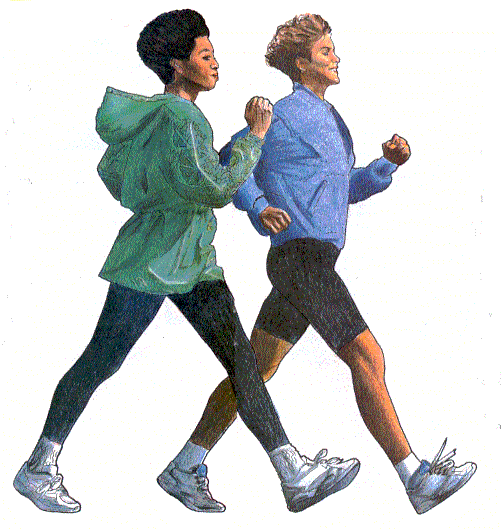












          |
   |

|
Walking at least half an hour, six days a week, can cut mortality rates from heart
disease in half.
– Cooper Institute for Aerobics Research. |
Cardiovascular disease is a serious health threat. Nearly 5 million Americans suffer from it. One of the safest and most effective ways to improve your cardiovascular fitness is by walking.
Walking is an ideal low impact aerobic exercise. If done regularly, it can reduce the risk of heart disease and cancer, lower total cholesterol, raise healthy HDL cholesterol and lower blood pressure. It can help maintain healthy bones and muscles, stabilize blood sugar, improve immunity and relieve some of the stress in your life. Thousands have realized the physical and psychological benefits of walking. That’s why walking has become one of the most popular ways to stay fit. Another reason is because it—s inexpensive–– all it takes is a little motivation and a comfortable pair of shoes.
According to the Cooper Institute for Aerobics Research, men who walk at least half an hour, six days a week, can cut their mortality rate from heart disease in half, compared with those who are sedentary. Studies show similar heart health benefits for women when they’exercise regularly. Now there’s a good reason to make a lifestyle change!
In 1996, just prior to the Olympic games in Atlanta, the Office of the Surgeon General reported on the health benefits derived from being physically active. The Surgeon General’s Report on Physical Activity and Health noted the following benefits of exercise:
A prolonged physical activity such as purposeful walking for 30 to 60 minutes daily can substantially increase energy expenditure. Regular walking can help control weight. When combined with a low-calorie, low-fat diet, walking daily can help reduce body weight and fat. It’s an effective calorie-burner. Walking at an even pace for 1 hour burns about 350 calories, while walking briskly and moving your arms with each stride can burn as much as 500 calories, depending upon your metabolism. In order to increase your metabolism, you need to workout nearly every day. And, the higher your metabolism, the faster you burn calories. Once you increase your metabolism, you will continue to burn calories even after you’ve finished exercising. Imagine burning calories even while you sleep!
Walking can help ease back discomfort. In one study, 64% of people reported a substantial decrease in back pain after instituting an exercise therapy program like walking.
Walking boosts energy levels. Just ten minutes of brisk walking is enough to boost your mood and energy for 1 to 2 hours. Studies show that those who exercise have more energy and a lower incidence of illness.
Walking fights the aging process. Women spend hundreds of dollars each year on cosmetics trying to look younger, but the best anti-aging formula doesn’t come in a bottle and it’s free.
To maximize the benefits of any aerobic exercise, you must sustain an activity for at least 20 to 60 minutes at each session. If you are out of shape, start with a 10–minute workout and gradually add 2 minutes a week until you reach your goal.
Before you begin your walk, take a few moments to warm up by stretching your major muscle groups. Then, if you would like to transform a leisurely stroll into a bona fide workout, follow these guidelines used by the famous marathon walker Ruth Artz:
You needn’t make it your ambition to train and look like an Olympic athlete to reap the many health benefits of walking. What’s important is that you maintain a healthy weight and achieve a certain degree of conditioning. Even a leisurely walk for 20-30 minutes a day is beneficial. If you don’t have 20 minutes to spare, at least do two 10-minute walks. Just do it. The key to your success lies within yourself, so lace up your sneaks and put one foot in front of the other and you will be starting your own walking program for better health.
Related links: For tips on maintaining an exercise program, go to Fitness for Life
This page was contributed by Ralph C. Bencivengo, D.C., C.C.S.P. and Colleen M. Mulryne, D.C. Dr. Bencivengo practices chiropractic medicine at Body Rehab Fitness Center, Hamilton Township, NJ.
Grateful acknowledgement to Health Impressions for graphic of two women walkers. Used with permission.
Diet and Exercise Log | Exercising Safely | An Exercise Calendar | Strength Training | Starting a Walking Program | Stretching Exercises | Relaxation Exercises | Living with Mindfulness | Intro to Exercise | Yoga
Disclaimer | Donate Now | Contact Us | Site Map | Store
|
©1999-2000; updates: 2002, 2004, 2005, 2007 Women's Heart Foundation, Inc. All rights reserved. Unauthorized use prohibited. The information contained in this Women's Heart Foundation (WHF) Web site is not a substitute for medical advice or treatment, and WHF recommends consultation with your doctor or health care professional. |